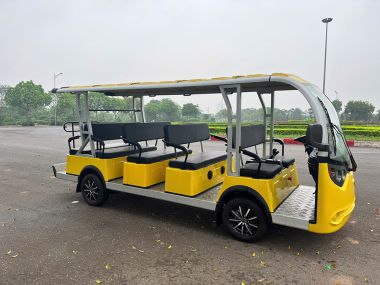Electric Tourism Vehicles – The Perfect Solution for Green and Clean Journeys
In recent years, as climate change and environmental pollution become increasingly severe, the use of electric vehicles in tourism has become a global trend. Electric tourism vehicles are not only an effective solution to reduce air pollution but also contribute to providing greener, cleaner, and more sustainable travel experiences. In this article, we will explore the benefits of electric vehicles for tourism, the factors driving this trend, and why electric tourism vehicles are the future of the tourism industry.

1. What Are Electric Tourism Vehicles?
Electric tourism vehicles are powered by batteries instead of gasoline or diesel, and they are specially designed for sightseeing, moving around tourist areas, resorts, and conservation zones. These electric vehicles come in various sizes and styles, from small vehicles for 2-4 people to larger ones that can carry a group of tourists.
These vehicles are typically used in environmentally sensitive areas such as national parks, nature reserves, or resorts where preserving the landscape and minimizing emissions is a top priority.
2. Benefits of Electric Vehicles in Tourism
2.1. Reducing Environmental Pollution
One of the greatest benefits of electric tourism vehicles is their ability to minimize environmental pollution. Unlike vehicles that run on gasoline or diesel, electric vehicles produce no CO2 emissions or other harmful pollutants, helping maintain clean air and preserve the natural ecosystem. This is especially important in areas like national parks and nature reserves, where the habitats of many wildlife species need protection, making electric vehicles the perfect choice.
2.2. Quiet and Peaceful Travel Experience
Electric vehicles operate quietly, helping reduce noise pollution and providing a peaceful, relaxing experience for tourists. In nature tours, people don’t want to be disturbed by loud engine noises; instead, they want to enjoy the natural sounds, such as birds chirping and wind rustling through the trees. With their noise-free engines, electric vehicles offer the most immersive experience with nature.
2.3. Cost-Effective and Low Maintenance
Electric vehicles are not only environmentally friendly but also cost-effective. The cost of charging an electric vehicle is much lower than fueling a gasoline-powered vehicle. Additionally, the maintenance costs are lower since electric vehicles do not require regular maintenance for parts like the transmission, cooling system, or exhaust system.
This helps tourism businesses save costs while providing tourists with affordable, high-quality services.
3. Practical Applications of Electric Vehicles in Tourism
3.1. Electric Vehicles in Eco-Tourism Areas
Eco-tourism destinations are dedicated to preserving the environment and ensuring the sustainability of natural ecosystems. Electric vehicles are the ideal solution for moving tourists through sensitive areas without harming the environment. In many nature reserves, electric vehicles are used to transport tourists, helping minimize human intervention in wildlife habitats.
3.2. Electric Vehicles in High-End Resorts
In high-end resorts, electric vehicles are used to transport guests from one area to another, enhancing comfort and convenience. Electric vehicles not only save time but also create a tranquil environment, allowing guests to relax and enjoy fresh air.
3.3. Electric Vehicles at Historical Tourist Sites
At historical tourist sites, preserving a quiet atmosphere is crucial. Electric tourism vehicles are the perfect mode of transport for exploring historical sites without disrupting the landscape or architecture. This helps protect cultural and historical values while providing an excellent experience for visitors.
4. Challenges and Solutions
4.1. Charging Time
One challenge for electric tourism vehicles is the relatively long charging time compared to refueling gasoline vehicles. However, with continuous advancements in battery technology, charging times are gradually decreasing. Fast-charging solutions, larger battery capacities, and the establishment of charging stations at tourist locations are helping address this issue.
4.2. Initial Investment Cost
While operating costs for electric vehicles are low, the initial investment to purchase an electric vehicle is relatively high compared to traditional vehicles. However, with support from governments and green tourism incentives, this cost is gradually being balanced, making it easier for tourism businesses to adopt electric vehicles.
5. The Future of Electric Vehicles in Tourism
Electric tourism vehicles are gradually becoming the new standard in global tourism. With advancements in technology and a growing awareness of the importance of protecting the environment, electric vehicles are the inevitable choice for the future of the tourism industry. Major tourism companies are investing heavily in electric vehicles, not only to meet customer demand but also to demonstrate their commitment to sustainable development.
Switching to electric vehicles also helps tourism businesses build an environmentally friendly brand image, attracting more eco-conscious tourists.
6. Representative Electric Tourism Vehicle Models
Many electric tourism vehicle models are now widely used in tourist destinations, resorts, and conservation areas. Some notable models include:
-
Club Car Villager 2: This is a popular electric vehicle in resorts and tourist areas, known for its compact design, comfort, and smooth ride. The Club Car Villager 2 is equipped with a Lithium-ion battery, providing high performance and long-lasting usage.
-
EZ-GO Express S4: EZ-GO is one of the leading electric vehicle brands, with the Express S4 designed for extensive tours, especially in large areas and complex terrains. It can carry 4-6 passengers, making it ideal for group tours.
-
Yamaha Adventurer Sport 2+2: This sporty model is designed for eco-resorts and eco-tourism destinations. The Yamaha Adventurer Sport 2+2 offers exceptional power and performance, ensuring a comfortable experience for users.
Conclusion
Electric tourism vehicles are increasingly asserting their importance in creating green, clean journeys, providing sustainable travel experiences while protecting the environment. With their outstanding benefits in reducing air pollution, saving costs, and providing a peaceful environment, electric tourism vehicles not only meet user needs but also contribute to the development of a more sustainable tourism industry.
The future of tourism will undoubtedly be closely linked to the development of electric vehicles—vehicles that help us explore the world while respecting and protecting nature. The shift towards electric vehicles is not only beneficial for tourists and businesses but also a major step in our efforts to protect our green planet.




